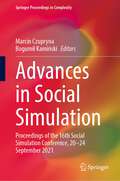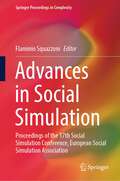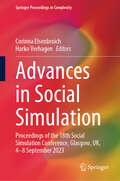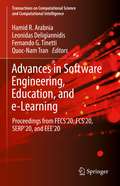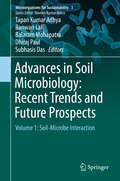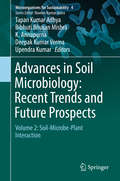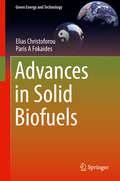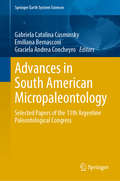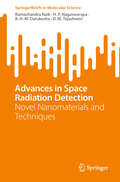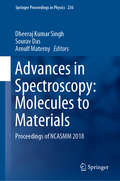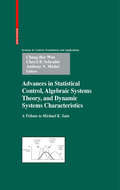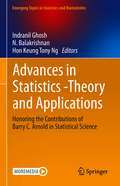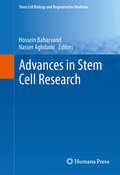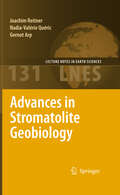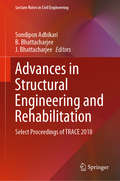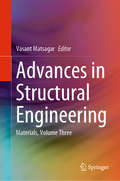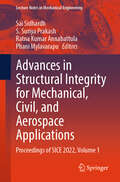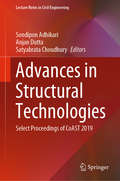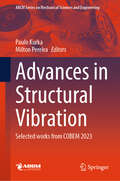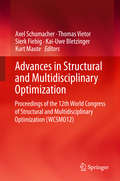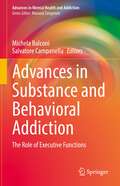- Table View
- List View
Advances in Social Simulation: Proceedings of the 16th Social Simulation Conference, 20–24 September 2021 (Springer Proceedings in Complexity)
by Bogumił Kamiński Marcin CzuprynaThis book covers the latest advances in applying agent-based modelling in social sciences. The Social Simulation Conference is the major global conference devoted to this topic. It is aimed at promoting social simulation and computational social science. This year’s special theme is “Social Simulation geared towards Post-Pandemic times”, focused not only on questions raised by the current pandemic but also on future challenges related to economic recovery, such as localization, globalization, inequality, sustainable growth and social changes induced by progressive digitalization, data availability and artificial intelligence. The primary audience of this book are scholars and practitioners in computational social sciences including economics, business, sociology, politics, psychology and urban studies.
Advances in Social Simulation: Proceedings of the 17th Social Simulation Conference, European Social Simulation Association (Springer Proceedings in Complexity)
by Flaminio SquazzoniThis book highlights recent developments in the field of computer simulation and its application to social dynamics and behaviour. It covers latest advancements in the use of agent-based modelling by focusing on thematic issues, methodological progress and applications, including policy, industry and business. It aims to promote this interdisciplinary type of research by showing synergies, complementary and integration especially between computer sciences, social sciences, economics and organization, often bridging qualitative and quantitative research. The primary audience of this book are academics, practitioners and professionals using computer simulation for business counselling or industry.
Advances in Social Simulation: Proceedings of the 18th Social Simulation Conference, Glasgow, UK, 4–8 September 2023 (Springer Proceedings in Complexity)
by Corinna Elsenbroich Harko VerhagenThis book contains the proceedings of the 18th Social Simulation Conference (SSC) and covers the state of the art of social simulation modeling. The SSC is the annual conference of the European Social Simulation Association (ESSA) and the major global conference devoted to this topic. It is aimed at promoting social simulation and computational social science. The book is the biggest collection of agent-based modeling research. It covers all aspects of modeling, from theory and philosophy of modeling to question of model design, purpose, and structure, using data, visualization, model interrelation, and open modeling. This book is targeted at researchers in social simulation regardless of disciplinary backgrounds, across career stages and different sectors, such as academia, industry, and policy
Advances in Software Engineering, Education, and e-Learning: Proceedings from FECS'20, FCS'20, SERP'20, and EEE'20 (Transactions on Computational Science and Computational Intelligence)
by Hamid R. Arabnia Quoc-Nam Tran Leonidas Deligiannidis Fernando G. TinettiThis book presents the proceedings of four conferences: The 16th International Conference on Frontiers in Education: Computer Science and Computer Engineering + STEM (FECS'20), The 16th International Conference on Foundations of Computer Science (FCS'20), The 18th International Conference on Software Engineering Research and Practice (SERP'20), and The 19th International Conference on e-Learning, e-Business, Enterprise Information Systems, & e-Government (EEE'20). The conferences took place in Las Vegas, NV, USA, July 27-30, 2020 as part of the larger 2020 World Congress in Computer Science, Computer Engineering, & Applied Computing (CSCE'20), which features 20 major tracks. Authors include academics, researchers, professionals, and students. This book contains an open access chapter entitled, "Advances in Software Engineering, Education, and e-Learning".Presents the proceedings of four conferences as part of the 2020 World Congress in Computer Science, Computer Engineering, & Applied Computing (CSCE'20);Includes the tracks Computer Engineering + STEM, Foundations of Computer Science, Software Engineering Research, and e-Learning, e-Business, Enterprise Information Systems, & e-Government;Features papers from FECS'20, FCS'20, SERP'20, EEE'20, including one open access chapter.
Advances in Soil Microbiology: Volume 1: Soil-microbe Interaction (Microorganisms For Sustainability #3)
by Tapan Kumar Adhya Banwari Lal Balaram Mohapatra Dhiraj Paul Subhasis DasThis book presents a comprehensive collection of articles illustrating the importance of microbial community structure and function for ecosystem sustainability and environmental reclamation. It addresses a diverse range of topics, including microbial diversity, physiology, genomics, ecosystem function, interaction, metabolism, and the fruitful use of microbial communities for crop productivity and environmental remediation. <P><P> In addition, the book explores issues ranging from general concepts on the diversity of microorganisms in soil, and ecosystem function to the evolution and taxonomy of soil microbiota, with future prospects. It covers cutting-edge methods in soil microbial ecological studies, rhizosphere microflora, the role of organic matter in plant productivity, biological nitrogen fixation and its genetics, microbial transformation of plant nutrients in soil, plant-growth-promoting rhizobacteria, and organic matter transformation. <P> The book also discusses the application of microbes in biodegradation of xenobiotic contaminants. It covers bio-fertilizers and their role in sustainable agriculture and soil health, biological control of insect pests and plant pathogens, and the latest tools of omics in soil microbiology, i.e. genomics, proteomics, transcriptomics and metabolomics, which offer pioneering approaches to the exploration of microbial structure and function.
Advances in Soil Microbiology: Volume 2: Soil-Microbe-Plant Interaction (Microorganisms for Sustainability #4)
by K. Annapurna Tapan Kumar Adhya Bibhuti Bhusan Mishra Deepak Kumar Verma Upendra KumarThis book presents a comprehensive collection of articles illustrating the importance of microbial community structure and function for ecosystem sustainability and environmental reclamation. It addresses a diverse range of topics, including microbial diversity, physiology, genomics, ecosystem function, interaction, metabolism, and the fruitful use of microbial communities for crop productivity and environmental remediation. In addition, the book explores issues ranging from general concepts on the diversity of microorganisms in soil, and ecosystem function to the evolution and taxonomy of soil microbiota, with future prospects. It covers cutting-edge methods in soil microbial ecological studies, rhizosphere microflora, the role of organic matter in plant productivity, biological nitrogen fixation and its genetics, microbial transformation of plant nutrients in soil, plant-growth-promoting rhizobacteria, and organic matter transformation. The book also discusses the application of microbes in biodegradation of xenobiotic contaminants. It covers bio-fertilizers and their role in sustainable agriculture and soil health, biological control of insect pests and plant pathogens, and the latest tools of omics in soil microbiology, i. e. genomics, proteomics, transcriptomics and metabolomics, which offer pioneering approaches to the exploration of microbial structure and function.
Advances in Solid Biofuels (Green Energy and Technology)
by Elias Christoforou Paris A FokaidesSolid biofuels, in different trading forms, constitute an integral component of the energy mix of almost all developed and developing countries. Either in the form of pellets, briquettes, chips, firewood, or even as raw feedstock, solid biofuels are used mainly in the heating and power sector. Numerous sustainability concerns, focusing on the environmental, economic and technical aspects of solid biofuels exploitation, led to considerable advances in the recent years in this field. These developments mainly focus on the pre-treatment processes of the solid biomass to biofuels chain, the minimum requirements of the produced solid biofuels, as well as the efficiency and the environmental performance of their thermochemical conversion routes. This work aspires to provide the state of the art in the field of the exploitation of solid biofuels to present the main advances as well as the major challenges of this scientific fields. The topics presented in this book were examined and dealt with by the authors in the past few years, in numerous research projects and scientific publications. This book compiles all the assembled experience of the past few years, and aims to provide an overview of the solid biofuels exploitation field.Presents the latest standards and considerations on solid biofuels technical requirements;Contains numerous examples on applications in the field of solid biofuels thermochemical conversion, as well as the state of the art in this field;Includes sustainability aspects, including life cycle assessment aspects and financial concerns for the exploitation of solid biofuels.
Advances in South American Micropaleontology: Selected Papers of the 11th Argentine Paleontological Congress (Springer Earth System Sciences)
by Gabriela Catalina Cusminsky Emiliana Bernasconi Graciela Andrea ConcheyroThis book offers many examples of calcareous microfossils and describes a new microfaunistic record in Argentina. These selected papers of the 11th Argentine Paleontological Congress include micropaleontological studies on material of different geological ages from several sites in Argentina and Colombia. The authors highlight several geological findings and explain the paleoenvironmental changes in Argentina and Colombia.
Advances in Space Radiation Detection: Novel Nanomaterials and Techniques (SpringerBriefs in Molecular Science)
by H. P. Nagaswarupa Ramachandra Naik B. H. Darukesha D. M. TejashwiniThis brief explores the development and enhancement of space radiation detection systems through the integration of advanced nanomaterials, specifically focusing on metal oxide nanomaterials such as ZrO2. It covers the synthesis, characterization, and thermoluminescence properties of these nanomaterials, as well as their incorporation into plastic scintillators to improve detection efficiency. The book also discusses the challenges and advancements in creating reliable radiation detection technology for space exploration, highlighting potential applications and future directions in the field. It is a useful resource for scientists and graduate students involved in the fields of space exploration, radiation detection technologies, and nanotechnology.
Advances in Spectroscopy: Proceedings of NCASMM 2018 (Springer Proceedings in Physics #236)
by Dheeraj Kumar Singh Sourav Das Arnulf MaternyThis book presents and discusses recent developments in the broad field of spectroscopy, providing the reader with an updated overview. The main objective is to introduce them to recent innovations and current trends in spectroscopy applied to molecules and materials. The book also brings together experimentalists and theoreticians to highlight the multidimensional aspects of spectroscopy and discuss the latest issues. Accordingly, it provides insights not only into the general goals of spectroscopy, but also into how the various spectroscopic techniques represent a toolbox that can be used to gain a more detailed understanding of molecular systems and complex chemical problems. Besides technical aspects, basic theoretical interpretations of spectroscopic results are also presented. The spectroscopy techniques discussed include UV-visible absorption spectroscopy, Raman spectroscopy, IR absorption spectroscopy, fluorescence spectroscopy, and time-resolved spectroscopy. In turn, basic tools like lasers and theoretical modeling approaches are also presented. Lastly, applications for the characterization of fundamental properties of molecules (environmental aspects, biomolecules, pharmaceutical drugs, hazardous molecules, etc.) and materials (nanomaterials, nuclear chemistry materials, biomaterials, etc.) are discussed. Given its scope, the book offers a valuable resource for researchers from various branches of science, and presents new techniques that can be applied to their specific problems.
Advances in Spinal Fusion: Molecular Science, BioMechanics, and Clinical Management
by Kai-Uwe LewandrowskiAdvances in Spinal Fusion reveals a new generation of materials and devices for enhanced operations in spinal fusion. This reference showcases emerging research and technologies in areas such as biodegradable implants, drug delivery, stem cell isolation and transfection, cell encapsulation and immobilization, and the design of 2D and 3D scaffolds for cells. It captures a cascade of innovations crucial to increased healing and decreased morbidity in spinal fusion methods and mechanics and addresses current standards in analytical methodology and quality control, it describes the selection of biomaterials for improved biocompatibility, biostability, and structure/function relationships.
Advances in Statistical Bioinformatics: Models and Integrative Inference for High-Throughput Data
by Kim-Anh Do Zhaohui Steve Qin Marina VannucciProviding genome-informed personalized treatment is a goal of modern medicine. Identifying new translational targets in nucleic acid characterizations is an important step toward that goal. The information tsunami produced by such genome-scale investigations is stimulating parallel developments in statistical methodology and inference, analytical frameworks, and computational tools. Within the context of genomic medicine and with a strong focus on cancer research, this book describes the integration of high-throughput bioinformatics data from multiple platforms to inform our understanding of the functional consequences of genomic alterations. This includes rigorous and scalable methods for simultaneously handling diverse data types such as gene expression array, miRNA, copy number, methylation, and next-generation sequencing data. This material is written for statisticians who are interested in modeling and analyzing high-throughput data. Chapters by experts in the field offer a thorough introduction to the biological and technical principles behind multiplatform high-throughput experimentation.
Advances in Statistical Control, Algebraic Systems Theory, and Dynamic Systems Characteristics: A Tribute to Michael K. Sain (Systems & Control: Foundations & Applications)
by Anthony N. Michel Cheryl B. Schrader Chang-Hee WonThis volume is a collection of chapters covering recent advances in stochastic optimal control theory and algebraic systems theory. The book will be a useful reference for researchers and graduate students in systems and control, algebraic systems theory, and applied mathematics. Requiring only knowledge of undergraduate-level control and systems theory, the work may be used as a supplementary textbook in a graduate course on optimal control or algebraic systems theory.
Advances in Statistics - Theory and Applications: Honoring the Contributions of Barry C. Arnold in Statistical Science (Emerging Topics in Statistics and Biostatistics)
by N. Balakrishnan Hon Keung Tony Ng Indranil GhoshThis edited collection brings together internationally recognized experts in a range of areas of statistical science to honor the contributions of the distinguished statistician, Barry C. Arnold. A pioneering scholar and professor of statistics at the University of California, Riverside, Dr. Arnold has made exceptional advancements in different areas of probability, statistics, and biostatistics, especially in the areas of distribution theory, order statistics, and statistical inference. As a tribute to his work, this book presents novel developments in the field, as well as practical applications and potential future directions in research and industry. It will be of interest to graduate students and researchers in probability, statistics, and biostatistics, as well as practitioners and technicians in the social sciences, economics, engineering, and medical sciences.
Advances in Stem Cell Research (Stem Cell Biology and Regenerative Medicine)
by Hossein Baharvand Nasser AghdamiAdvances in Stem Cell Research discusses recent advances in stem cell science, including therapeutic applications. This volume covers such topics as biomanufacturing iPS cells for therapeutic applications, techniques for controlling stem cell fate decisions, as well as current basic research in such areas as germ line stem cells, genomics and proteomics in stem cell research. It is a useful book for biology and clinical scientists, especially young investigators and stem cell biology students who are newly entering the world of stem cells research. The editors hope that the new knowledge and research outlined in this book will help contribute to new therapies for a wide variety of diseases that presently afflict humanity.
Advances in Stereology for Neuroscience (Neuromethods #208)
by Javier Bernacer María García-AmadoThis volume discusses the latest advancements used in various stereological methods to study different neural structures. The chapters in this book cover topics such as microglia measurements, estimation of axonal length, morphological analysis of large nuclei such as the human caudate nucleus, assessments of tissue damage after spinal cord injury in rodents, and the application of automatic stereological methods and artificial intelligence to neural tissue. In the Neuromethods series style, chapters include the kind of detail and key advice from the specialists needed to get successful results in your laboratory. Cutting-edge and comprehensive, Advances in Stereology for Neuroscience is a valuable resource for researchers who are interested in learning more about this important and developing field.
Advances in Stromatolite Geobiology (Lecture Notes in Earth Sciences #131)
by Joachim Reitner Gernot Arp Nadia-Valérie QuéricStromatolites are the most intriguing geobiological structures of the entire earth history since the beginning of the fossil record in the Archaean. Stromatolites and microbialites are interpreted as biosedimentological remains of biofilms and microbial mats. These structures are important environmental and evolutionary archives which give us information about ancient habitats, biodiversity, and evolution of complex benthic ecosystems. However, many geobiological aspects of these structures are still unknown or only poorly understood. The present proceedings highlight the new ideas and information on the formation and environmental setting of stromatolites presented at the occasion of the Kalkowsky Symposium 2008, held in Göttingen, Germany.
Advances in Structural Engineering and Rehabilitation: Select Proceedings of TRACE 2018 (Lecture Notes in Civil Engineering #38)
by Sondipon Adhikari B. Bhattacharjee J. BhattacharjeeThis book comprises select papers presented at the International Conference on Trends and Recent Advances in Civil Engineering (TRACE 2018). The book covers a wide range of topics related to recent advancements in structural engineering, structural health monitoring, rehabilitation and retrofitting of structures, and earthquake-resistant structures. Based on case studies and laboratory investigations, the book highlights latest techniques and innovative methods for building repair and maintenance. Recent development in materials being used in structural rehabilitation and retrofitting is also discussed. The contents of this book can be useful for researchers and professionals working in structural engineering and allied areas.
Advances in Structural Engineering: Materials, Volume Three
by Vasant MatsagarThe book presents research papers presented by academicians, researchers, and practicing structural engineers from India and abroad in the recently held Structural Engineering Convention (SEC) 2014 at Indian Institute of Technology Delhi during 22 - 24 December 2014. The book is divided into three volumes and encompasses multidisciplinary areas within structural engineering, such as earthquake engineering and structural dynamics, structural mechanics, finite element methods, structural vibration control, advanced cementitious and composite materials, bridge engineering, and soil-structure interaction. Advances in Structural Engineering is a useful reference material for structural engineering fraternity including undergraduate and postgraduate students, academicians, researchers and practicing engineers.
Advances in Structural Integrity for Mechanical, Civil, and Aerospace Applications: Proceedings of SICE 2022, Volume 1 (Lecture Notes in Mechanical Engineering)
by Phani Mylavarapu Sai Sidhardh S. Suriya Prakash Ratna Kumar AnnabattulaThis book presents select proceedings of the 4th Structural Integrity Conference and Exhibition (SICE-2022), organized at the Indian Institute of Technology, Hyderabad. This book includes chapters written by eminent scientists and academicians broadly working in aerospace, civil, and mechanical and materials engineering within the areas of structural integrity, life prediction, and condition monitoring. These chapters are classified under the domains of aerospace, fracture mechanics, fatigue, civil structures, experimental techniques, computation mechanics, molecular dynamics and nanostructures, smart materials, energy impact, dynamics, mechanisms, structural optimization, composites, AI/ML applications, additive and advanced manufacturing, bio-engineering, structural health monitoring, nondestructive testing, and damage and failure analysis. The book can be a valuable reference for researchers, students and practicing engineers.
Advances in Structural Technologies: Select Proceedings of CoAST 2019 (Lecture Notes in Civil Engineering #81)
by Sondipon Adhikari Anjan Dutta Satyabrata ChoudhuryThis book comprises select proceedings of the National Conference on Advances in Structural Technology (CoAST 2019). It brings together different applied and technological aspects of structural engineering. The main topics covered in this book include solid mechanics, composite structures, fluid-structure interaction, soil-structure interaction, structural safety, and structural health monitoring. The book also focuses on emerging structural materials and the different behavior of civil, mechanical, and aerospace structural systems. Given its contents, this book will be a useful reference for researchers and practitioners working in structural safety and engineering.
Advances in Structural Vibration: Select Proceedings of ICOVP 2017 (Lecture Notes in Mechanical Engineering)
by Subashisa Dutta Santosha Kumar Dwivedy Esin InanThis book consists of selected and peer-reviewed papers presented at the 13th International Conference on Vibration Problems (ICOVP 2017). The topics covered in this book include different structural vibration problems such as dynamics and stability under normal and seismic loading, and wave propagation. The book also discusses different materials such as composite, piezoelectric, and functionally graded materials for improving the stiffness and damping properties of structures. The contents of this book can be useful for beginners, researchers and professionals interested in structural vibration and other allied fields.
Advances in Structural Vibration: Selected works from COBEM 2023 (Lecture Notes in Mechanical Engineering)
by Paulo Kurka Milton PereiraThis book is a compilation of selected works presented at COBEM 2023, emphasizing the field of dynamics and vibrations. It showcases a diverse array of cutting-edge research, ranging from the investigation of metastructures for vibration attenuation in crankshafts to the application of metamaterials for reducing wind tower vibrations. Each chapter offers unique insights and advancements in structural dynamics and vibrations. With contributions encompassing experimental investigations, analytical studies, and practical applications, this book is an invaluable resource for researchers, engineers, and practitioners in the field.
Advances in Structural and Multidisciplinary Optimization: Proceedings of the 12th World Congress of Structural and Multidisciplinary Optimization (WCSMO12)
by Axel Schumacher Thomas Vietor Sierk Fiebig Kai-Uwe Bletzinger Kurt MauteThe volume includes papers from the WSCMO conference in Braunschweig 2017 presenting research of all aspects of the optimal design of structures as well as multidisciplinary design optimization where the involved disciplines deal with the analysis of solids, fluids or other field problems. Also presented are practical applications of optimization methods and the corresponding software development in all branches of technology.
Advances in Substance and Behavioral Addiction: The Role of Executive Functions (Advances in Mental Health and Addiction)
by Salvatore Campanella Michela BalconiThis book deals with recent perspectives on the panel of addiction behavior in a vast amount of population (young and adult). Thanks to the contribution of experts of the topic of addiction the volume will furnish new perspectives to formulate assessment, diagnosis and intervention in response to the increasing variety of addictions. It focuses the assessment of executive functions in substance and behavioral addictions. More specifically, this assessment consists of a new approach not only inherent to the diagnosis, but also to the treatment and prevention of addictions. In fact, there is a strict relationship between executive functions (EF) and addictive behavior: EF plays a remarkable role in significant phenomena for the treatment of addictions, such as craving, relapse and compliance to treatment.
